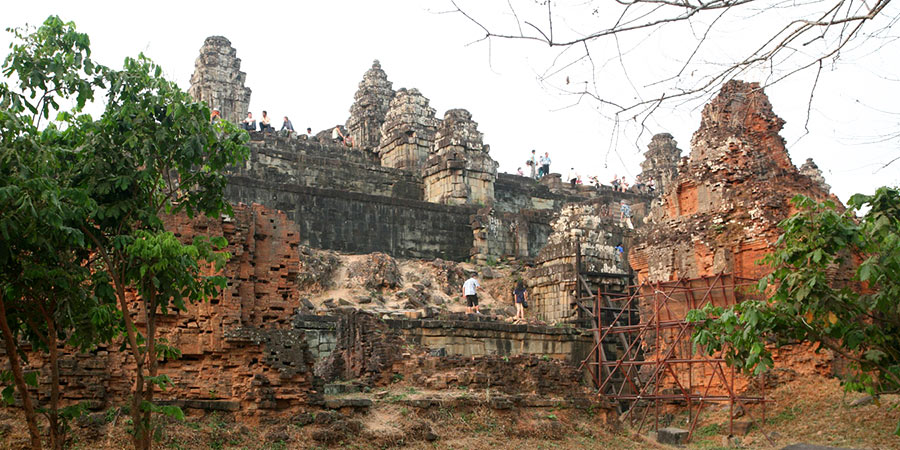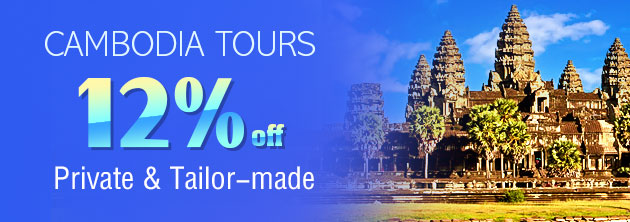Phnom Bakheng
Cambodia’s Angkor Archaeological Park is home to ancient Hindu and Buddhist temples that date back to the days of the Angkor Empire. The temples in this region were condemned to being forgotten, as ancient Angkor was abandoned way back in time.However, curiosity drove archaeologists, conservators, and explorers to Angkor in the 1930s, where they uncovered a plethora of architectural treasures that would forever change the fortunes of the South-East Asian countries.
One of the temples discovered by explorers was Phnom Bakheng, which is one of Angkor’s most popular destinations today. Over the course of this article, we will find out all there is to know about the ancient temple and how you can reach it on your visit to Cambodia.

Cambodia Phnom Bakheng
|
When and Who Built the Phnom Bakheng?
After much restoration work, archaeologists uncovered the origins of the Phnom Bakheng Temple and shared them with the world. The temple dates back to the days of the late 9th century when the ancient kingdom of Angkor was ruled by King Yasovarman.The temple was built under his rule and it was the most stunning architectural feat in the then-capital city of Yasodharapura, where Yasovarman moved to from another treasured site in Angkor, Roluos (previously known as Hariharalaya).
Which God was the Temple Dedicated To?
The majority of temples that you would find in the Angkor Archaeological Park were built as Hindu temples in honor of different Hindu gods. The Phnom Bakheng temple was dedicated to Lord Shiva, one of Hinduism’s principal deities.Why is the Temple so Important?
The Phnom Bakheng temple is not an ordinary temple from ancient Angkor. It is a mountain temple, something that the ancient Khmers are admired for to this day for building.While you can witness a plethora of wonderful temples in the ruins of Angkor today, it’s hard to fathom that once, mountain temples barely existed. Phnom Bakheng was one of the first mountain temples to be built by the ancient Khmer architects, following which more began to be constructed.
The temple also served as King Yasovarman I’s tomb.
|
|
|
Some Architectural Elements in the Temple
The seven levels of the temple in the shape of a pyramid are symbolic of some important elements of Hindu beliefs. The pyramid-shaped structure is meant to symbolize the Himalayan peak of Mount Meru, which Hindus believe is the abode of Hinduism’s principal deities. The seven levels also represent the seven heavens of Hinduism.108 towers featured on the lower and upper levels of the temple, which were symbolic of four 27-day long lunar phases. Unfortunately, only a few of these towers remain to this day.
The temple also features several bas reliefs, a common feature that is shared among most Hindu and Buddhist temples constructed by the ancient Khmers.
There are also approximate outlines of two Buddha statues, which were probably added when the people of Angkor converted from Hinduism to Buddhism.
Can Angkor Wat be seen from Phnom Bakheng?
Phnom Bakheng is known for being the highest temple in the Angkor Archaeological Park. Its location at the top of a hill also makes it a great place to witness some jaw-dropping panoramic views of the other temples in the park.Angkor Wat can be seen quite clearly from the topmost level of Phnom Bakheng and many people come to the temple just to behold the sight of mighty Angkor Wat from a much higher perspective.
See More: How to Visit Angkor Wat
Best Time of the Day to Visit Phnom Bakheng
Phnom Bakheng experiences the highest tourist footfall during the hours of sunset, which is one of the most special experiences to have in the temple premises.Unfortunately, its reputation as a sunset spot has somewhat endangered it. During the peak tourist season, there are huge crowds jostling for space at the top of the temple, which is a thoroughly unpleasant affair.
The irresponsible activities of tourists here have forced authorities to limit visitors to the temple to 300 at any one time. If you want to avoid the crowds, then pay a visit to the temple in the morning to enjoy the panoramic views of ancient Angkor and its historic monuments on your own.
How to Reach Phnom Bakheng Temple?
Phnom Bakheng is approximately 8 km (5 miles) away from Siem Reap and to reach the temple, you can hire any one of the following transport options:• Bicycles: Bicycle rental shops can be found throughout Siem Reap, with charges ranging from $1-5 depending on the type of bicycle you choose. You can choose from speed bikes, city bikes and mountain bikes.
• Tuk-tuks: Tuk-tuk tours of Phnom Bakheng and other prominent Angkor temples would require you to spend around $15-25.
• Taxis: Taxi tours are much more expensive than tuk-tuk tours and may set you back by $25-50 depending on how many temples you want to visit.
The best way to get there is to take a taxi or a tuk tuk. It costs $20-$30 per day by taxi whereas tuk-tuk cost you $8-$12 per day.
The temple is located near the ancient capital city of Angkor Thom, at a 400-meter (1,312 ft.) distance to Angkor Thom’s south. Most people visit the main Angkor Wat temple complex first and then proceed towards Phnom Bakheng.
If you are planning on doing the same, then simply go up the Bakheng hill, on which the temple is located. The road up the side of the hill is quite sandy, but it is the only way up to the temple. Once you head up all the way, you can find the foot of the temple, from where you have to go up a flight of narrow and steep stairs to make your way up to the top of the temple.
Ticket & Entry Fee
To enter the temple premises, you need to buy the Angkor Temple pass, which offers access to the entirety of the Angkor Archaeological Park. Simply go to the ticket counter on your way to the park and buy your pass from three available options:• $37 one-day passes
• $62 three-day passes
• $72 seven-day passes
Be careful not to lose the temple pass, as there may be security checks inside the park premises after you enter. If you are found without a pass, it would only be an excuse for the guards to extract a handsome amount from you as fine.


